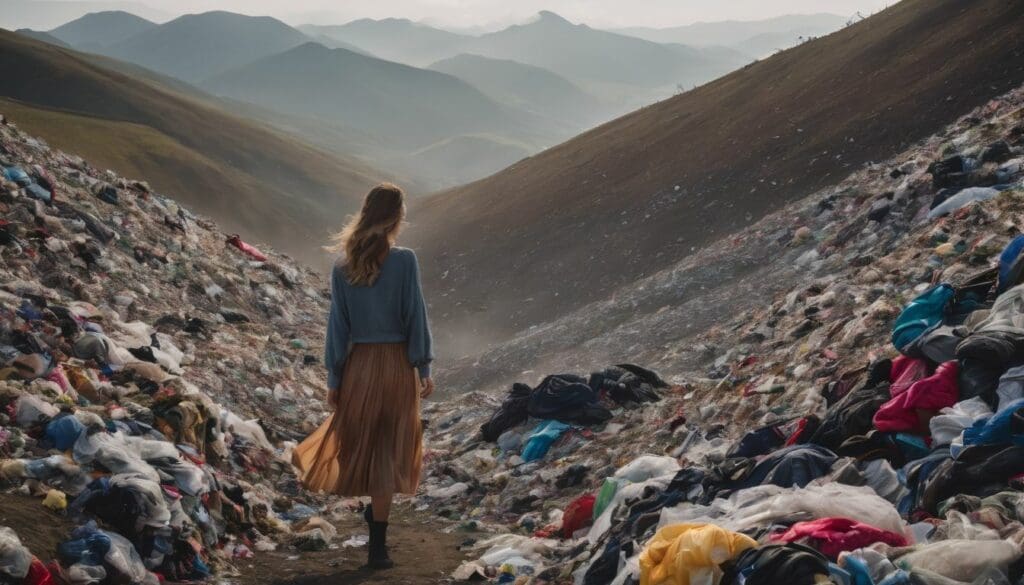Like countless others, we’re often tempted by the latest trends showcased in our preferred high street stores. It’s easy to be enticed by the allure of these fashionable finds that promise a quick style fix without breaking the bank.
However, there’s more to this picture than meets the eye. Our feature delves beneath the surface to uncover the true cost of fast fashion—not just on our wallets but on our planet and its inhabitants too.
As you peruse this piece, you’ll gain valuable insights into how each choice we make can contribute to a more considerate approach towards fashion. The power for change lies within your grasp!
Key Takeaways
- Fast fashion contributes to a staggering 92 million tons of textile waste annually, which leads to the overuse and depletion of natural resources like water and cotton.
- Garment workers in subcontracted factories often face poor wages, unsafe conditions, and human rights violations including child labour.
- Fashion industry pollution not only causes environmental damage but also poses health risks for local communities due to toxic chemical exposure from production processes.
- Change can be driven by supporting brands that adhere to ethical practices, investing in durable clothing, and pushing for government regulations on corporate accountability.
- Embracing circular economy practices is key – this includes repairing or upcycling clothes, adopting second-hand shopping habits, and making conscious choices about clothing consumption.
The True Cost of Fast Fashion
The true cost of fast fashion extends beyond the price tag, encompassing economic, environmental, and social impacts. From the exploitation of workers to the depletion of natural resources, the consequences of cheap clothes are far-reaching and often hidden from view.
Economic impacts
Fast fashion brands like Zara and H&M lure us in with trendy designs at low prices, but there’s a hidden economic toll. These seemingly innocuous purchases contribute to an unsustainable cycle that undervalues both the clothes we wear and the labour used to make them.
Subcontracted factories churn out massive quantities of disposable clothing, which leads not only to environmental damage but also strains our global economy.
We overlook how these short-lived items quickly turn into waste, adding 92 million tonnes of textile refuse yearly – imagine a lorryload of discarded garments landing in landfills every second.
This reckless consumerism puts immense pressure on our planet’s resources and necessitates costly clean-up efforts and waste management solutions that could be avoided with more sustainable practices.
By choosing cheap over ethical, we unwittingly feed an industry where sustainability costs are alarmingly high—costs that ultimately affect us all as they ripple through economies around the world.
Environmental impacts
Transitioning from the economic impacts of fast fashion, we must acknowledge the substantial environmental consequences. Fast fashion contributes to a staggering 92 million tons of textile waste annually, burying the planet under an avalanche of discarded clothes.
This rampant production is causing irreversible damage, with factories emitting harmful pollutants and consuming vast amounts of resources in materials sourcing. The insatiable demand for trendy yet inexpensive clothing fuels mass production in substandard conditions, further exacerbating the environmental toll.
We cannot overlook the dire implications that fast fashion has on our planet and society. The statistics are alarming, reflecting not only ecological devastation but also widespread social repercussions.
Social impacts
Fast fashion has significant social impacts, including worker exploitation and substandard working conditions. The rush for cheap, trendy clothing often leads to human rights violations and labor exploitation in subcontracted factories.
This not only affects the workers but also their local communities, contributing to a range of social problems. Additionally, the pressure to produce inexpensive clothes at a rapid pace results in negative consequences for the environment as well as society.
The social value of conscious consumerism is crucial in addressing these hidden costs associated with fast fashion. By advocating for ethical clothing and supporting sustainable fashion initiatives, consumers can play a pivotal role in mitigating the adverse social effects caused by the industry’s current practices.
The Cost of Cheap Clothes
Cheap clothes often come with a hidden cost, including human rights violations, labour exploitation, and resource depletion. These issues are prevalent in the fast fashion industry and have far-reaching social and environmental impacts.
Human rights violations
Subcontracted factories where trendy, inexpensive clothes are mass-produced often violate human rights by subjecting workers to poor working conditions and meagre wages. The production of fast fashion has been associated with exploitative labour practices, including child labour, long working hours without fair compensation, and unsafe working environments.
Garment workers in these factories are often denied fundamental human rights such as the freedom to association and collective bargaining.
Furthermore, discriminatory policies and harassment against marginalised groups within the workforce are prevalent in many fast fashion supply chains. Women make up a significant portion of the garment industry’s workforce and face gender-based discrimination on a regular basis.
Labour exploitation
Fast fashion brands often exploit workers in subcontracted factories, with poor wages and unsafe working conditions. This leads to human rights violations and a cycle of poverty for those employed in the industry.
The demand for cheap clothes has created a system that prioritises profit over fair treatment of workers, perpetuating exploitation and suffering.
Workers in fast fashion supply chains face long hours, low pay, and lack of job security. As a result, they endure physical and emotional stress while struggling to make ends meet.
Resource depletion
The fashion industry’s pursuit of cheap materials and rapid production has led to significant resource depletion. The high demand for cotton, water, and other raw materials has resulted in overexploitation of natural resources.
Approximately 100 billion garments are produced every year, contributing to the depletion of non-renewable resources and exacerbating environmental damage.
Furthermore, the relentless consumption of textile fibers leads to excessive use of land and water. For instance, 20,000 liters of water are required to produce one kilogram of cotton – a concerning statistic given that this valued resource is becoming increasingly scarce.
Solutions for a Sustainable Fashion Industry
We can make a difference by supporting ethical and sustainable brands, embracing circular economy practices, and encouraging mindful and conscious consumption. Learn more about how we can create a fair and sustainable fashion future.
Promoting ethical and sustainable brands
We endorse and support brands that prioritise ethical practices and sustainability, playing a pivotal role in transforming the fashion industry. Here’s how we can actively engage in promoting these brands:
- Embrace transparency: Choose brands that openly disclose their production processes, material sourcing, and labour practices. Look for certifications like Fair Trade or GOTS (Global Organic Textile Standard) to ensure ethical standards are met.
- Educate others: Spread awareness about the impact of fast fashion and the benefits of supporting ethical brands. Engage with communities through social media or local events to highlight the importance of sustainable fashion choices.
- Make informed purchases: Prioritise quality over quantity by investing in timeless pieces from ethical brands that are committed to eco-friendly materials, fair wages, and responsible manufacturing.
- Advocate for change: Support initiatives and campaigns that promote sustainable fashion practices and encourage industry stakeholders to adopt ethical standards. Use your voice to demand accountability from fashion companies.
- Collaborate with influencers: Join forces with like-minded individuals and influencers who advocate for sustainable fashion. By leveraging their platforms, you can amplify the message of promoting ethical brands to a wider audience.
Embracing circular economy practices
- Extending the lifespan of clothing by repairing or upcycling items, reducing the amount of textile waste entering landfills.
- Using eco-friendly materials and production techniques to create durable, high-quality garments that can be recycled or biodegraded at the end of their lifecycle.
- Implementing take-back or buy-back programmes that allow consumers to return old clothing for reuse or recycling, promoting a closed-loop system.
- Encouraging collaborative consumption through clothing rental services, enabling individuals to access a variety of styles without contributing to excessive consumption.
- Supporting brands and initiatives that prioritise transparency in their supply chain, ensuring ethical practices and accountability throughout the production process.
Encouraging mindful and conscious consumption
To promote a sustainable fashion industry, we can take steps to encourage mindful and conscious consumption. This means making informed choices and being aware of the impact of our clothing purchases. Here are some ways we can achieve this:
- Educate ourselves about eco – friendly clothing options, such as organic cotton, hemp, or recycled materials which reduce environmental impact.
- Prioritise quality over quantity by investing in timeless pieces that are durable and versatile, rather than following fleeting trends.
- Support ethical and sustainable brands that prioritise fair labour practices and environmentally friendly production methods.
- Embrace the concept of a minimalist wardrobe, focusing on essentials and avoiding impulse buys that contribute to textile waste.
- Adopt a “repair, reuse, recycle” mindset by mending or repurposing old clothes instead of discarding them, thereby extending their lifespan.
- Consider the true cost of fast fashion by evaluating the social and environmental implications before making a purchase.
- Engage in second-hand shopping or clothing swaps to give pre-loved items a new lease on life while reducing demand for new fast fashion products.
- Challenge ourselves to resist the allure of excessive consumerism and instead find joy in mindful purchasing habits that align with our values and beliefs.
The Impact of Fast Fashion on Local Communities
Pollution from textile dyeing and manufacturing processes leads to health hazards for local residents. Additionally, the rise of fast fashion has caused a decline in traditional craftsmanship and cultural appropriation within these communities.
Pollution and health hazards
Cheap, disposable clothing from fast fashion brands leads to significant pollution and health hazards. The production process of these clothes involves the release of toxic chemicals into the air and water, contributing to environmental degradation.
Moreover, textile waste from these brands often ends up in landfills, creating a breeding ground for pollutants that can seep into soil and water sources, posing serious health risks.
Fast fashion’s impact on local communities includes increased exposure to harmful substances due to factory emissions and inadequate waste management practices.
The detrimental effects of fast fashion extend beyond environmental degradation to jeopardising public health. Workers in garment factories face hazardous working conditions such as exposure to toxic chemicals used in dyeing fabrics.
Loss of traditional craftsmanship
Fast fashion’s demand for speed and low-cost production has led to the decay of traditional craftsmanship. Skilled artisans and their time-honoured techniques are being sidelined in favour of mass-produced, machine-made clothing.
The rich heritage and cultural significance embedded in traditional craftsmanship are at risk of fading into obscurity as fast fashion continues to dominate the market, perpetuating a cycle that devalues artisanal skills.
Many ecofriendly clothing enthusiasts advocate for embracing sustainable practices that honour traditional craftsmanship. By supporting brands that prioritise ethical production methods and preserve artisanal skills, consumers can actively contribute to safeguarding centuries-old techniques from extinction.
Cultural appropriation
Fast fashion has been criticised for perpetuating cultural appropriation by exploiting traditional designs and patterns from indigenous communities without giving credit or proper compensation.
This practice lacks respect for the heritage and significance of these cultural symbols, leading to erasure of their origins and meanings. Additionally, fast fashion brands sometimes profit from sacred or ceremonial designs that hold deep cultural value, causing harm to those cultures and violating their rights.
This issue highlights the need for ethical sourcing practices within the fashion industry, in order to avoid exploiting and appropriating traditional craftsmanship.
Government and Industry Responsibility
Governments and industries have a crucial role in addressing the environmental and social impacts of fast fashion. Regulations must be implemented to enforce ethical practices, hold corporations accountable for their actions, and invest in sustainable technologies for a fair and sustainable fashion future.
Need for regulations and enforcement
The fashion industry’s environmental and social problems can be addressed through regulations and enforcement. These actions are crucial in holding corporations accountable and ensuring ethical and sustainable practices. Government bodies, alongside industry leaders, need to collaborate to establish and implement stringent laws that govern the production, distribution, and disposal of clothing. Such regulations will encompass environmental protection measures, fair labour standards, waste management guidelines, and transparency in supply chains. Additionally, rigorous enforcement will involve regular monitoring, audits, penalties for non-compliance, and support for sustainable innovations. By prioritizing regulations and enforcement in the fashion industry, we can pave the way for a fair and sustainable future.
Holding corporations accountable
- Encouraging transparent supply chains to trace the origins of products and ensure ethical practices are followed, thus holding companies accountable for their sourcing and production methods.
- Implementing fair labour standards and ensuring workers’ rights are respected throughout the supply chain, which would place responsibility on corporations to prioritise fair treatment of their employees.
- Imposing penalties for environmental violations and incentivising sustainable practices within the fashion industry, thereby making corporations answerable for their impact on the environment.
- Enforcing regulations that hold brands responsible for the end – life of their products, such as implementing extended producer responsibility (EPR) programmes to manage textile waste effectively.
- Engaging consumers by providing them with information about brands’ ethical and environmental practices, allowing them to make informed choices and indirectly holding corporations accountable through consumer demand.
- Instituting independent audits and inspections of factories and production facilities to ensure compliance with labour, environmental, and ethical standards, thereby placing accountability on corporations to maintain these standards.
- Monitoring corporate actions through oversight bodies empowered to penalise non – compliance with regulations or ethical standards, creating a system where companies are answerable for their actions.
- Collaborating with industry stakeholders to create industry – wide initiatives that establish ethical benchmarks and hold corporations collectively responsible for meeting these standards.
Investing in sustainable practices and technologies
- Implementing eco-friendly materials such as organic cotton, hemp, and recycled fabrics can significantly reduce the environmental impact of clothing production. This reduces the need for resource-intensive processes and minimises waste.
- Embracing innovative technologies like 3D printing and digital manufacturing can streamline production processes, minimise material waste, and reduce energy consumption in textile manufacturing.
- Investing in research and development of sustainable dyeing and finishing techniques that utilise natural dyes or water-saving methods can help lower chemical pollution and water usage in garment production.
- Supporting the adoption of renewable energy sources like solar or wind power within textile factories can drastically cut down on greenhouse gas emissions associated with clothing production.
- Collaborating with tech companies to develop cutting-edge recycling technologies for textiles can lead to a closed-loop system where old garments are repurposed into new products, reducing the amount of textile waste ending up in landfills.
- Encouraging transparency throughout the supply chain by utilising blockchain technology to trace the origins of materials, ensuring ethical sourcing and fair treatment of workers across all stages of production.
- Promoting investment in sustainable fashion startups that focus on circular economy models, encouraging creativity and innovation while driving positive change within the industry.
- Advocating for policy changes that incentivise sustainable practices, such as tax breaks or subsidies for businesses implementing eco-friendly initiatives, fostering a more supportive environment for sustainable fashion endeavours.
Conclusion: Embracing Change for a Fair and Sustainable Fashion Future
Embracing change for a fair and sustainable fashion future requires collective action. We must promote ethical and sustainable brands, embracing circular economy practices. Holding corporations accountable and advocating mindful consumption are essential steps.
It’s crucial to demand regulations, enforce accountability, and invest in sustainable technologies for a better tomorrow.
FAQs
1. What is the environmental fallout of fast fashion?
The environmental cost of fast fashion includes pollution, excessive water consumption, and a high amount of waste due to cheap clothes being quickly discarded.
2. How does fast fashion affect workers?
Fast fashion often leads to poor working conditions, unfair wages, and exploitation in the clothing industry affecting social aspects for many workers.
3. Can buying cheap clothes have a long-term impact?
Yes, purchasing inexpensive and trendy items contributes to the cycle of waste and damage linked to these environmental and social costs.
4. Are there alternatives to supporting fast fashion?
Choosing ethical brands that prioritise sustainable practices helps reduce both the environmental footprint and improves social conditions within the clothing industry.





